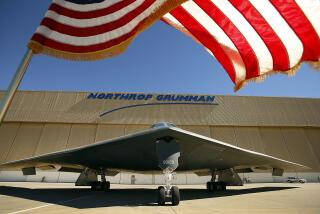Deal Would Let Northrop Branch Out
- Share via
The proposed acquisition of TRW Corp. would bring Northrop Grumman Corp. one step closer to creating a network of weapons and electronic systems across all three military services, a feat that is at the crux of the Bush administration’s push to transform the Pentagon.
With TRW, which agreed Monday to be acquired for $7.8 billion, Northrop would have interests in virtually every sector of the defense industry, offering everything from ships to satellites to lasers to aircraft to computer networks.
The breath of its businesses essentially would give Northrop elite status among contractors able to provide “system of systems” integration--a complex and lucrative task to oversee multibillion-dollar defense contracts.
Beyond strengthening Century City-based Northrop’s position in the defense industry, the TRW acquisition also would make it the leading supplier of computer network services to the federal government.
The combination of Northrop’s and TRW’s information technology businesses would propel the combined company past Lockheed Martin Corp. as the nation’s largest provider of computer network systems for the U.S. government.
TRW Systems, based in Reston, Va., generates about $2 billion in annual revenue and recently won a five-year, $650-million contract to provide computer stations and supply management software to the Air Force and the Pentagon. It developed and currently maintains the database system for the Securities and Exchange Commission and is helping to modernize the computer system for the Internal Revenue Service.
Through its acquisitions of Logicon, PRC and now Cleveland-based TRW, Northrop would maintain many of the government’s computer systems, including the Web site for the White House and the networks for the nation’s most secret agencies, such as the National Reconnaissance Organization.
But Northrop’s acquisition strategy in the last decade has aimed at giving it a bigger role in defense, particularly in developing systems that could be “inter-operable” among the military services. The Air Force, Navy, Marine Corps and Army currently design and develop weapons and communications systems separately.
Lockheed and Boeing Co., the nation’s two largest defense contractors, also have a wide range of products, but they are focused mainly toward meeting the needs of a particular military service, said Richard Aboulafia, a defense analyst for Teal Group.
TRW essentially would give Northrop “the widest net of products across all the services,” Aboulafia said. And with such an arsenal, Northrop would be able to meet its objective “to tie them all together in a network.”
Indeed, Northrop’s aspiration is summed up by an illustration posted at its facilities, showing ships, aircraft, spy planes and satellites linked by common electronic systems. Also known as network-centric warfare, the term has been Northrop’s mantra for years.
Northrop, which developed and manufactured the B-2 stealth bomber, no longer focuses development on so-called platforms, or the structures that make up an airplane, but on the electronic brains and sensors that it believes will give the U.S. military significant battlefield advantage.
The addition of TRW would complete the transformation, analysts said. It would give Northrop entry to growing areas of defense, including missile defense, space-based weapons and space sensors. The capability would help increase Northrop’s ability to go after large-scale system integration jobs.
The deal also would elevate Northrop to playing a role as a prime contractor in areas in which it has ranked only as a subcontractor. For example, TRW is the prime contractor on developing the Space-Based Infrared Low system of satellites that would orbit the Earth looking for intercontinental ballistic missiles.
Moreover, TRW would give Northrop its first major presence with the Army. TRW currently is developing a battlefield identification system for the Army that would help U.S. forces distinguish a “friend from a foe.” It also is helping the Army replace its communication system.
“Northrop will finally have the capability to mate the sensor systems with TRW’s expertise in battlefield command and control systems,” said James McAleese, a defense lawyer who has been advising Northrop on the TRW acquisition.
Northrop would make so many products that airmen, soldiers, sailors and Marines would have hard time avoiding the brand. An aircraft carrier built at Northrop’s Newport News, Va., shipyard may have aircraft whose major components were supplied by Northrop, sailors logging onto computer networks developed by Northrop and communication systems linked to satellites built by Northrop.
“The synergy from these acquisitions will be more sublime than obvious,” said Paul H. Nisbet, a defense analyst for JSA Research Inc. “It will happen as they pull together additional technology capabilities they didn’t have before.”
More to Read
Inside the business of entertainment
The Wide Shot brings you news, analysis and insights on everything from streaming wars to production — and what it all means for the future.
You may occasionally receive promotional content from the Los Angeles Times.










